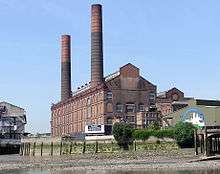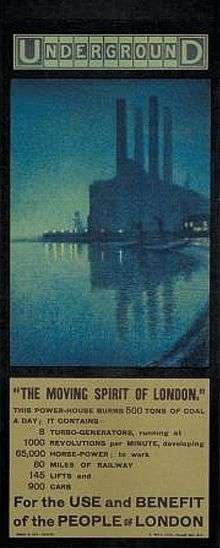Lots Road Power Station
| Lots Road Power Station | |
|---|---|
 Lots Road Power Station, viewed from the River Thames. | |
| Country | England |
| Location | Royal Borough of Kensington and Chelsea, Greater London |
| Coordinates | 51°28′40″N 0°10′53″W / 51.47785°N 0.18127°WCoordinates: 51°28′40″N 0°10′53″W / 51.47785°N 0.18127°W |
| Commission date | 1905 |
| Decommission date | 2002 |
| Thermal power station | |
| Primary fuel | Oil |
| Tertiary fuel | Coal |
| Power generation | |
| Nameplate capacity | 50 MW |
| grid reference TQ264770 | |
Lots Road Power Station is a disused coal and later oil-fired and later gas-fired power station on the River Thames at Lots Road in Chelsea, London in the south-west of The Royal Borough of Kensington and Chelsea, which supplied electricity to the London Underground system. It is sometimes erroneously referred to as Fulham Power Station, a name properly applied to another former station a mile upriver.
History
A power station at Lots Road was originally planned by the Brompton and Piccadilly Circus Railway (B&PCR, now part of the Piccadilly line) in 1897.[1] The B&PCR was controlled by the District Railway (DR, now the District line) from 1898, and was sold in 1901 to Charles Yerkes' Metropolitan District Electric Traction Company, which built the station to provide power to the DR. The station allowed the District line trains to change from steam haulage to electric. At around the same time the Metropolitan Railway built its power station at Neasden.

The station was built end-on to the Thames, on the north bank of the tidal Chelsea Creek. Construction started in 1902 and was completed in December 1904, the station becoming operational in February 1905.[2] The station burned 700 tonnes of coal a day and had a generating capacity of 50,000 kW.[3] At the time it was claimed to be the largest power station ever built, and it eventually powered most of the railways and tramways in the Underground Group.
The station was re-equipped and improved several times. During the early 1920s a sump & hopper system for more efficient fuel handling was installed. It was designed by The Underfeed Stoker Company and constructed under their stewardship by Peter Lind & Company, who still trade in London today. The modernisation undertaken in the 1960s converted the station to 50 Hz generation and from coal burning to heavy fuel oil. The number of chimneys was reduced from the original four to two. Between 1974 and 1977, with the discovery of natural gas in the North Sea, the boilers were converted to burn gas, with the option of oil firing if required. The station later worked in conjunction with the ex-London County Council Tramways power station at Greenwich to supply the London Underground network.
The station played a part in the birth of commercial radio in the UK. When the first two radio stations, LBC and Capital Radio, opened in October 1973, the site for their medium wave transmitters was not complete. As a result, a temporary 'Tee' antenna was strung up between the two chimneys (transmitting LBC on 417 m (719 kHz), and Capital Radio on 539 m (557 kHz)), until the permanent site at Saffron Green was ready in 1975. Some years later the site was used again, on 720 kHz (for a low power MW relay of BBC Radio 4's LW service) which was in use until 2001 when the radio transmitter was moved to Crystal Palace.
In the 1990s, it was decided not to re-equip Lots Road again; rather it was to continue to operate only until the machinery's life was expired. It was finally shut down on 21 October 2002, and since then all power for the tube system has been supplied from the National Grid.
Redevelopment
The property company that now owns the site wishes to convert the station into shops, restaurants and apartments, and to construct additional buildings, including two skyscrapers, on the adjoining vacant land. The scheme was delayed because Kensington and Chelsea Council refused planning permission for one of the towers. The other, Lots Road South Tower, actually the taller of the two, was granted permission by Hammersmith and Fulham Council, but the developer was unwilling to proceed without permission for the other one as well. On 30 January 2006 the Secretary of State granted planning permission for the development.[4] In 2007 the developer hoped to complete the scheme by 2013.[5] It has since been delayed by the economic downturn, and no revised date is yet available.
On 13 September 2010, Thames Water announced that they would be building their Thames Tideway super sewer. One of their preferred access sites adjoins the proposed Lots Road development site as shown on the Thames Water Website under Cremorne Wharf Foreshore. The consultation period ended in Autumn 2010.[6]
On 26 September 2013, developer Hutchison Whampoa Properties broke ground on the eight-acre site, rebranding it as "Chelsea Waterfront", with Mayor of London Boris Johnson speaking at the ceremony. The £1bn scheme will be "the biggest riverside development on the north bank [of the Thames] for over 100 years", and will create 706 homes. New planning and design details were conceived between 2010 and 2012. The construction for Phase One (100 apartments) is expected to be completed in 2015/16, and phase two, which includes the power station itself, in 2017/8.[7]
References
- ↑ Badsey-Ellis, Antony (2005). London's Lost Tube Schemes. Capital Transport. p. 71. ISBN 1-85414-293-3.
- ↑ Horne, Mike (2006). The District Line. Capital Transport. p. 40. ISBN 1-85414-292-5.
- ↑ http://www.museumoflondon.org.uk/English/Collections/OnlineResources/X20L/Themes/1337/1180/
- ↑ http://www.rbkc.gov.uk/News/general/lots_rd.pdf
- ↑ http://www.hutchison-whampoa.com/europe/eng/property/property.htm
- ↑ http://www.thamestunnelconsultation.co.uk/pdf/Cremorne_Wharf_Foreshore.pdf
- ↑ http://www.primeresi.com/the-other-power-station-lots-road-gets-1bn-makeover/22372/
External links
| Wikimedia Commons has media related to Lots Road Power Station. |
- Map sources for Lots Road Power Station
- Pictures from inside the power station
- MB21 Transmission Gallery - Lots Road Broadcast Site
- YouTube - Lots Road Power Station in a snowstorm
- YouTube - Demolition of part of the station during redevelopment
- YouTube - Demolition of part of the station during redevelopment
- - Thames Tideway
- Winchester, Clarence, ed. (1936), "Power for London's transport", Railway Wonders of the World, pp. 951–954
| Preceded by Carville A Power Station |
Largest Power Station in the UK 1905-1916 |
Succeeded by Carville B Power Station |
